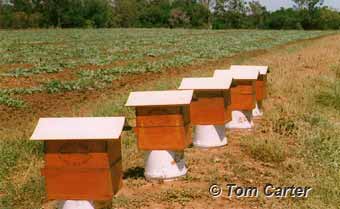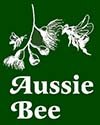WHAT IS POLLINATION AND WHY IS IT IMPORTANT?
Aussie Bee > Pollination with Native Bees
What is Pollination?
Many flowers cannot produce seeds unless pollen is carried from the male part of a flower to the female part. This process is called Pollination.
Without pollination, most wildflowers would not be able to produce new seedlings and gradually these flowers would disappear from our bushland.
Without pollination, many crop plants would not be able to produce the fruit, vegetables, nuts, seeds and oils which are an important part of the food we eat.
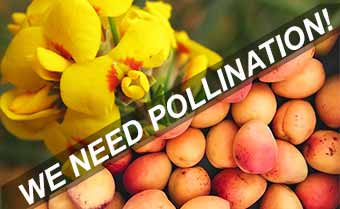
Pollination is vital for the survival of most of our Australian wildflowers and many of our food crop plants!
How Does Pollination Happen?
Pollen grains from the male part of a flower must be carried across to the female part of the flower. The pollen grains are usually carried by the wind or by bees and other insects.
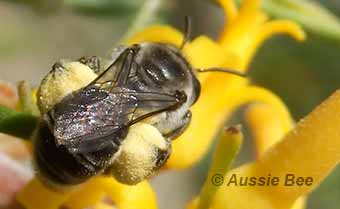
This Leioproctus native bee has packed pollen grains onto special hairy pads on her hind legs. When she visits the next flower, some pollen will rub off onto the flower, pollinating it.
In Australia, thousands of species of bees and other animals help to pollinate our plants. They include:
-- native bees such as Stingless Bees, Leafcutters, Blue Banded Bees and Carpenter Bees
-- European Honeybees
-- some flies, wasps, beetles, moths and butterflies
-- some birds, bats and other small mammals
Bees are particularly good pollinators because they need pollen to feed their young in their nests. During the day, bees visit hundreds of flowers to collect this pollen. Each time that they fly off to another flower, they leave some pollen on the female part of the flower. This pollinates the flower and helps the plant to produce seeds. It is a Win - Win situation for both the plant and the bee!
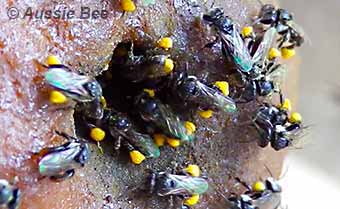
With Eucalyptus trees in bloom nearby, these native stingless bees are enthusiastically bringing large balls of yellow pollen home, into their nest in this hollow tree. The pollen is used to feed the immature bees inside the nest.
Pollinators for our Wildflowers
Many native bees visit a wide variety of flower species. However, Australian native bees have evolved in parallel with our wildflowers for millions of years. So it is not surprising that some native bees have developed very special ways to pollinate particular wildflowers.
Some native bees have evolved long tongues that can sip nectar from deep narrow flowers and others have specialised bristles that help them collect pollen. For instance, Persoonia Bees, Leioproctus (Cladocerapis), are specialist pollinators of the Persoonia or Geebung flower. Persoonia Bees have shiny smooth faces that help them reach deep into the flowers for nectar and they have dense bristles on their forelegs that they use to rake pollen out of special grooves in the flowers.
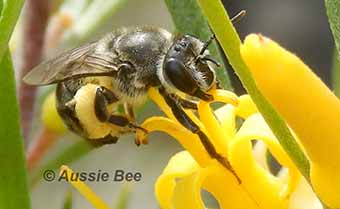
This Persoonia Bee is raking pollen from a Geebung flower using her front legs. She has coarse bristles on her front legs to help her do this. You can also see the shiny smooth plate on this bee's face that helps her slide her face between the flower's petals to collect nectar.
Other native bees can perform a special kind of pollination called 'Buzz Pollination'. These bees vibrate the flowers, making the pollen shoot out of little capsules. Some wildflowers, such as Solanum and Hibbertia, require Buzz Pollination to produce seeds. European Honeybees and our native Stingless Bees cannot perform Buzz Pollination. However, many types of native bees are Buzz Pollination experts, including:
-- Blue Banded Bees,
-- Teddy Bear Bees and
-- Carpenter Bees.
It is important to protect the diversity of our native bee species, so that we will always have bees to Buzz Pollinate our wildflowers!
Pollinators for our Food Crops
For some major food crops such as wheat, rice, corn and oats, wind carries the pollen that pollinates the plant.
However, many of our other food crops rely on insects (especially bees) and other animals for pollination, including:
-- apples, pears, peaches, melons and passionfruit;
-- pumpkins, zucchini, avocados and cucumbers;
-- brazil nuts, macadamia nuts, cashews and almonds;
-- canola and sunflower;
-- coffee, coconut, mustard and cotton.
Just one species, the European Honeybee, Apis mellifera, is currently used for large-scale commercial crop pollination in Australia. This is a serious problem, because European Honeybees are under threat by many pests and diseases. If (or when) Australia is invaded by the devastating Varroa mite, we will lose a large proportion of our European Honeybees.
However, for some food crops, Australia's 1,700 native bee species can be better crop pollinators than European Honeybees. For instance, many solitary native bees carry large amounts of dry pollen on their furry bodies, making them particularly efficient pollinators. Our social native Stingless Bees have a short flight range that helps keep them within a target crop or inside a crop greenhouse. And Blue Banded Bees and Carpenter Bees can perform the special Buzz Pollination technique needed for crops such as tomatoes, capsicums and blueberries.
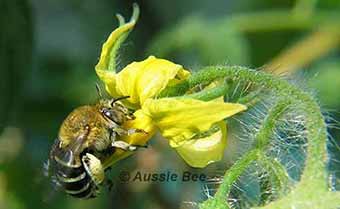
A Bluebanded Bee Buzz Pollinating a tomato flower inside a greenhouse. European Honeybees cannot perform Buzz Pollination.
The best result is achieved when European Honeybees and a variety of native bee species are used together to pollinate crops. So it is vital that we learn how to make better use of our wild pollinators for crop pollination in Australia. Major research programs on this subject are currently underway in New South Wales and South Australia.
Read more about Crop Pollination with Australian native bees.
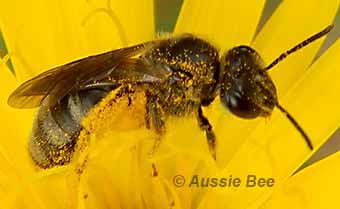
A solitary Lasioglossum bee with dry pollen grains caked on her hind legs and across her back. Dry pollen grains transfer readily to the female parts of flowers, making the process of Pollination easier. So these kinds of bees can be excellent pollinators.
How You Can Help
Our Australian native bees, which provide such essential pollination services, are under threat from the spread of our cities, broad scale agriculture methods and insecticide use. Gardeners can help support these vital pollinators by planting a Bee-Friendly Garden, by avoiding the use of insecticides and by setting up Bee Hotels.
Farmers can help by allowing wildflowers to grow on strips of land beside their crops or roads. This can increase the number and diversity of wild pollinators visiting their crops and so increase the crop yield.
We also need to learn much more about our Australian wild pollinators. You can help by participating in the Wild Pollinator Counts that are held Australia-wide twice a year. It only takes ten minutes to do a count and you do not need any specialised knowledge or equipment. To find out more, visit: https://wildpollinatorcount.com/
Further Reading
-- AgGuide: Australian Native Bees
-- The Australian Native Bee Book

